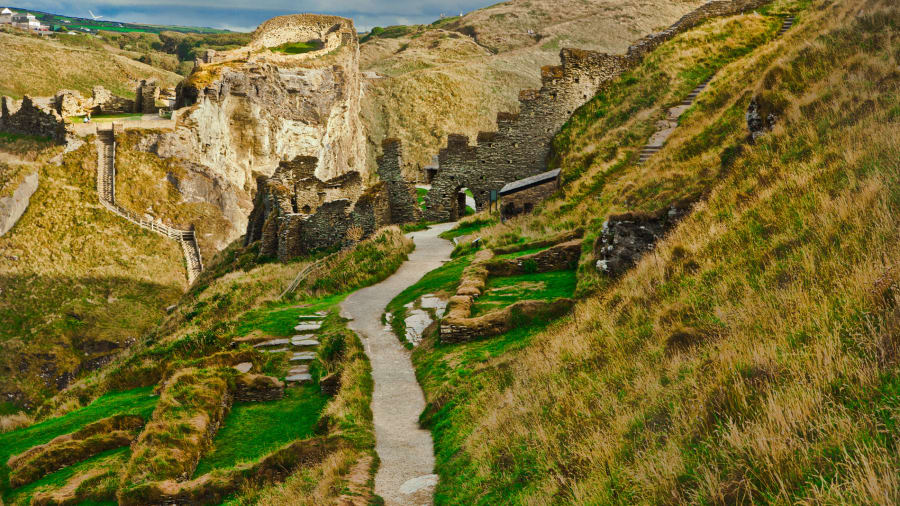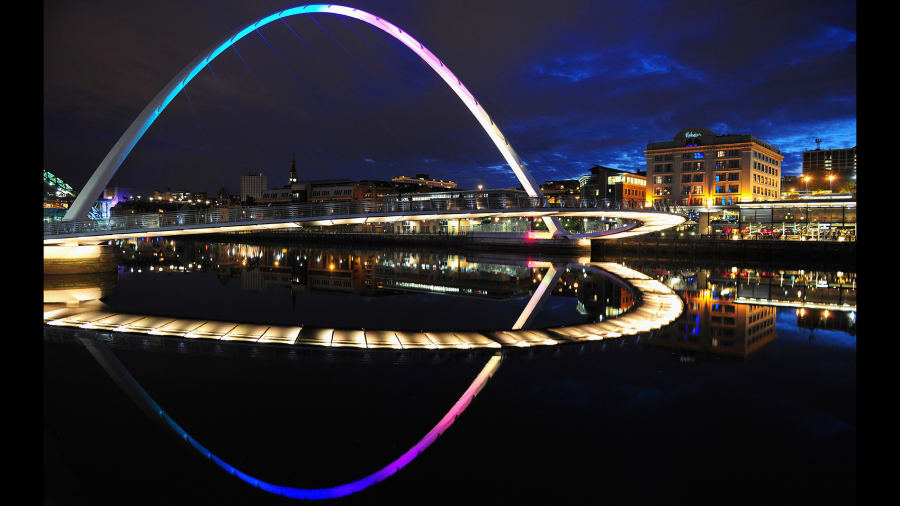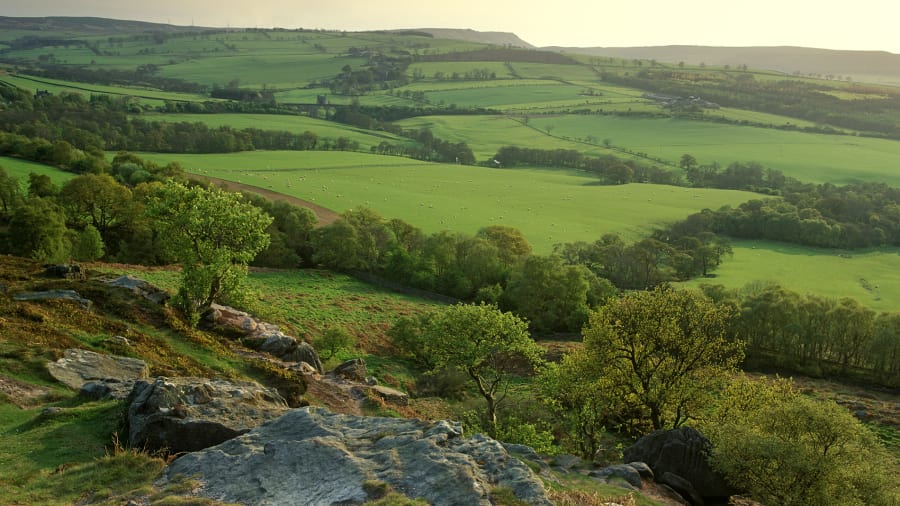 With the pound plummeting against other countries, it’s a good time to celebrate England’s most beautiful destinations. London, home to red double-decker buses and a commonly misnamed clock tower, was recently voted as the best tourist destination in the world by TripAdvisor.
With the pound plummeting against other countries, it’s a good time to celebrate England’s most beautiful destinations. London, home to red double-decker buses and a commonly misnamed clock tower, was recently voted as the best tourist destination in the world by TripAdvisor.

At 978 meters, Scafell Pike isn’t only the highest mountain in England, it also offers the best views of the unspoiled Wasdale Valley and Wastwater — the deepest lake in England. On a clear day Scotland, Wales, Ireland and the Isle of Man can be seen from the hilltops.

Windermere, 10.5 miles (17 kilometers) long and 219 feet (67 meters) deep, is England’s largest lake. Part of the scenic Lake District National Park, its small cruise boats welcome more than 1.2 million visitors each year.
Lake Windermere, Lake District National Park, Cumbria

The southern seaside town of Brighton has its own eccentric answer to the Taj Mahal. Built for King George IV, the 193-year-old Royal Pavilion is now open to the public as a museum. It houses an ice rink from November to January each year.

Standing only 13 kilometers from Stonehenge, Salisbury Cathedral in Wiltshire is one of England’s most beautiful churches. The structure, built between 1220 and 1258, has Britain’s tallest spire — 332 steps to the top of the tower — and Europe’s oldest working clock.
 The rolling landscapes of the Yorkshire Dales showcase stunning variety of features from waterfalls to caves to limestone pavements. Hikers can challenge themselves to the Three Peaks Walks, a trek to summit a trio of tough climbs, covering 38.6 kilometers, within 12 hours.
The rolling landscapes of the Yorkshire Dales showcase stunning variety of features from waterfalls to caves to limestone pavements. Hikers can challenge themselves to the Three Peaks Walks, a trek to summit a trio of tough climbs, covering 38.6 kilometers, within 12 hours.
 Let’s face it — England isn’t the most sought-after beach destination. That said, some 58 beaches around England have been awarded the internationally recognized Blue Flag, recognizing cleanliness and good facilities. With colorful beach huts, Minnis Bay (pictured) in the Kent village of Birchington-on-Sea, is one of them.
Let’s face it — England isn’t the most sought-after beach destination. That said, some 58 beaches around England have been awarded the internationally recognized Blue Flag, recognizing cleanliness and good facilities. With colorful beach huts, Minnis Bay (pictured) in the Kent village of Birchington-on-Sea, is one of them.
 Port Isaac is a small scenic fishing village in the northern part of Cornwall. It’s also the birthplace of Fisherman’s Friends, a singing group that specializes in sea shanties — another reason to love the place.
Port Isaac is a small scenic fishing village in the northern part of Cornwall. It’s also the birthplace of Fisherman’s Friends, a singing group that specializes in sea shanties — another reason to love the place.

Some rocks and fossils found in the Jurassic Coast, covering southern England’s Dorset and East Devon, are 185 million years old. It’s England’s first natural World Heritage Site. Durdle Door (pictured here) is an iconic natural limestone arch on the beach.

Founded in 1753, The British Museum was the world’s first national public museum. Today, it’s still easily one of the best galleries around the globe. It has a collection of eight million pieces — only 1% of which is on display. The signature Grand Court was designed by Norman Foster and was opened in 2000. Sutton Bank is where the heather-clad North York Moors give way to gorgeous views over the pancake-flat Vale of York. It’s one of the three Dark Sky Discovery Sites in the area for star-gazing.
Sutton Bank is where the heather-clad North York Moors give way to gorgeous views over the pancake-flat Vale of York. It’s one of the three Dark Sky Discovery Sites in the area for star-gazing.

With neo-classical temples, grottoes and bridges built around the lake, the 18th century
Stourhead estate is a perfect example of an English landscape garden.

The Needles are three isolated rocks (a forth needle-shaped rock, which gave the group its name, collapsed in 1764) in a line off the coast of the Isle of Wight. One of the best ways to see them is from a chairlift in the nearby Alum Bay.
 Hadrian’s Wall
Hadrian’s Wall spans 135 kilometers from Maryport in the west to Tyne and Wear in the east. The UNESCO World Heritage Site was built to keep tribal warriors out of the northern frontier of the ancient Roman Empire. In the picture is a section of the Roman wall near Housesteads Fort in Northumberland.

Yes, they’re much smaller than everyone thinks they’re going to be, but they’re still the best known cluster of rocks in Britain. We can’t be sure if
Stonehenge really was the
first Ikea-style flat pack, but the prehistoric monument never ceases to surprise. Last year, some more and larger stone monuments, dubbed “
Superhenge,” were discovered less than three kilometers from the site.
Corby Crags’ landscape is so stunning that it was used as a backdrop of Middle Earth in the
“The Hobbit”
movie poster in 2012. Corby Crags lies in Edlingham, a small village with 196 residents.

At 3.4 kilometers, York has England’s longest medieval
city wall. The well-preserved fortification makes a picturesque two-hour trail around the heritage city.

With rolling green fields and charming villages, Cotswolds is the largest of the 38 designated Areas of Outstanding Natural Beauty in England and Wales. Painswick (in the picture) is one of area’s historic towns.

Legend says
Tintagel Castle, a medieval structure on a rugged coastline of North Cornwall, is the birthplace of King Arthur. Below the castle is Tintagel Beach with emerald water and Merlin’s Cave, a hiding place for infant Arthur in poet Alfred Lord Tennyson’s “Idylls of the King.”

The Somerset city of Bath was inscribed a UNESCO World Heritage Site in 1987. It’s known for its
Roman baths — the only place in England for a natural thermal spa — and Georgian architecture.
As the biggest gorge in Britain,
Cheddar Gorge is home to some of the country’s most dramatic cliffs and rarest animals — like ancient Soay sheep. It’s listed as an Area of Outstanding Natural Beauty.

A sea fort constructed by Henry VIII in the 1540s,
St. Mawes Castle offered protection to the waterway of the River Fal until it surrendered to a land attack during the English Civil War. It’s regarded as the best preserved fort built by Henry VIII.

The coolest bridge in England? Costing £22 million ($31.7 million), the pedestrian Gateshead Millennium Bridge connecting Newcastle and Gateshead across the River Tyne is the world’s first tilting bridge, capable of leaning upwards to allow ships to navigate underneath. This website lists its
tilting schedule.
This beautiful hillside castle was built by King Henry II in the 1180s. In 2015 alone,
Dover Castle was featured in two TV and movie productions: “Avengers: Age of Ultron” and BBC’s “Wolf Hall.” In the cliffs underneath the castle lie a network of secret WWII tunnels and an underground hospital.

Abbey Garden is a tropical-style paradise with plant species from more than 80 countries — from Brazil to South Africa to Australia. The wild garden experiment began when Augustus Smith moved to and became the owner of
Tresco Island, 28 miles off the coast of southwestern Cornwall in 1834. The garden has continued to expand with the help of Smith’s descendants.

Top Withins (pictured here) is a ruined site on Haworth Moor. It’s said that the wild moorland inspired Emily Bronte’s “Wuthering Heights” when the Bronte sisters lived here.

Top Withins (pictured here) is a ruined site on Haworth Moor. It’s said that the wild moorland inspired Emily Bronte’s “Wuthering Heights” when the Bronte sisters lived here.
The gothic-style
Brompton Cemetery on Fulham Road is one of London’s most famous cemeteries. The cemetery has appeared in multiple movies including Pierce Brosnan’s first Bond outing “GoldenEye.” It’s also the home to the mysterious tombstone of Hannah Courtoys — read
London’s coolest gravestones to find out more.
An alien spaceship? Or a deep-sea creature? This futuristic landmark is the facade of a Selfridges department store in Birmingham. The building, covered in aluminum discs, is part of the city’s beloved
Bullring shopping center.
Considered one of the prettiest villages in England,
Castle Combe welcomed a spark of interest from tourists after it was used as a filming location for Steven Spielberg’s “War Horse” in 2011.

Source : cnn.com


 With the pound plummeting against other countries, it’s a good time to celebrate England’s most beautiful destinations. London, home to red double-decker buses and a commonly misnamed clock tower, was recently voted as the best tourist destination in the world by TripAdvisor.
With the pound plummeting against other countries, it’s a good time to celebrate England’s most beautiful destinations. London, home to red double-decker buses and a commonly misnamed clock tower, was recently voted as the best tourist destination in the world by TripAdvisor.
 The rolling landscapes of the Yorkshire Dales showcase stunning variety of features from waterfalls to caves to limestone pavements. Hikers can challenge themselves to the Three Peaks Walks, a trek to summit a trio of tough climbs, covering 38.6 kilometers, within 12 hours.
The rolling landscapes of the Yorkshire Dales showcase stunning variety of features from waterfalls to caves to limestone pavements. Hikers can challenge themselves to the Three Peaks Walks, a trek to summit a trio of tough climbs, covering 38.6 kilometers, within 12 hours. Let’s face it — England isn’t the most sought-after beach destination. That said, some 58 beaches around England have been awarded the internationally recognized Blue Flag, recognizing cleanliness and good facilities. With colorful beach huts, Minnis Bay (pictured) in the Kent village of Birchington-on-Sea, is one of them.
Let’s face it — England isn’t the most sought-after beach destination. That said, some 58 beaches around England have been awarded the internationally recognized Blue Flag, recognizing cleanliness and good facilities. With colorful beach huts, Minnis Bay (pictured) in the Kent village of Birchington-on-Sea, is one of them. Port Isaac is a small scenic fishing village in the northern part of Cornwall. It’s also the birthplace of Fisherman’s Friends, a singing group that specializes in sea shanties — another reason to love the place.
Port Isaac is a small scenic fishing village in the northern part of Cornwall. It’s also the birthplace of Fisherman’s Friends, a singing group that specializes in sea shanties — another reason to love the place. Sutton Bank is where the heather-clad North York Moors give way to gorgeous views over the pancake-flat Vale of York. It’s one of the three Dark Sky Discovery Sites in the area for star-gazing.
Sutton Bank is where the heather-clad North York Moors give way to gorgeous views over the pancake-flat Vale of York. It’s one of the three Dark Sky Discovery Sites in the area for star-gazing.
 Hadrian’s Wall spans 135 kilometers from Maryport in the west to Tyne and Wear in the east. The UNESCO World Heritage Site was built to keep tribal warriors out of the northern frontier of the ancient Roman Empire. In the picture is a section of the Roman wall near Housesteads Fort in Northumberland.
Hadrian’s Wall spans 135 kilometers from Maryport in the west to Tyne and Wear in the east. The UNESCO World Heritage Site was built to keep tribal warriors out of the northern frontier of the ancient Roman Empire. In the picture is a section of the Roman wall near Housesteads Fort in Northumberland.








































